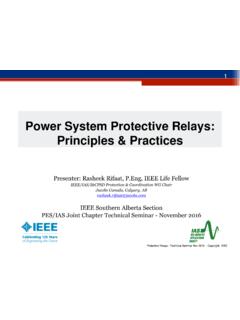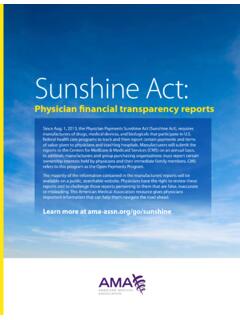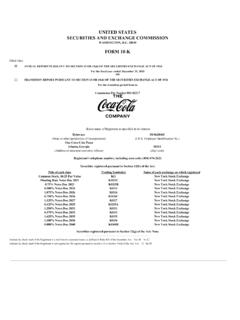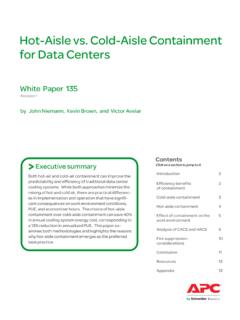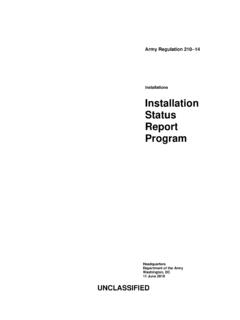Transcription of Army Programs Army Lessons Learned Program
1 UNCLASSIFIED Army Regulation 11 33 Army Programs Army Lessons Learned Program Headquarters Department of the Army Washington, DC 14 June 2017 SUMMARY of CHANGE AR 11 33 Army Lessons Learned Program This expedite revision, dated 14 June 2017 o Changes references to Army Force Generation to Sustainable Readiness Model (para 1 6). o Adds requirement for capability of exchange of information at all levels of classification to include Special Access Programs and Alternative Compensatory Control Measures (para 1 6). o Defines issues, trends, and capability gaps and explains their use within the Army Lessons Learned Program (fig 3 1 and glossary).
2 O Defines role of lesson manager in organizations (para 3 3). o Provides further explanation of the need for synchronized collection and production effort in order for the Army Lessons Learned Program community to fully support Army requirements (app C). o Replaces Army Lessons Learned Community, Lessons Learned community, and Lessons Learned community of practice with a single term: Army Lessons Learned Program community (throughout). *This regulation supersedes AR 11-33, dated 1 April 2016. AR 11 33 14 June 2017 UNCLASSIFIED i Headquarters Department of the Army Washington, DC *Army Regulation 11 33 14 June 2017 Effective 14 July 2017 Army Programs Army Lessons Learned Program History.
3 This publication is an expedite revision. The portions affected by this revi-sion are listed in the summary of change. Summary. This regulation establishes policy, procedures, and responsibilities for Armywide management of the Army Les-sons Learned Program . Applicability. This regulation applies to the Active Army, the Army National Guard/Army National Guard of the United States, and the Army Reserve, unless otherwise stated. Proponent and exception authority. The proponent of this regulation is the Dep-uty Chief of Staff, G 3/5/7. The proponent has the authority to approve exceptions or waivers to this regulation that are consistent with controlling law and regulations.
4 The proponent may delegate this approval au-thority, in writing, to a division chief within the proponent agency or its direct reporting unit or field operating agency, in the grade of colonel or the civilian equivalent. Activ-ities may request a waiver to this regulation by providing justification that includes a full analysis of the expected benefits and must include formal review by the activ-ity s senior legal officer. All waiver re-quests will be endorsed by the commander or senior leader of the requesting activity and forwarded through their higher head-quarters to the policy proponent.
5 Refer to AR 25 30 for specific guidance. Army internal control process. This regulation contains internal control provi-sions in accordance with AR 11 2 and iden-tifies key internal controls that must be evaluated (see appendix D). Supplementation. Supplementation of this regulation and establishment of com-mand and local forms are prohibited with-out prior approval from the Deputy Chief of Staff, G 3/5/7 (DAMO ZA), 400 Army Pentagon, Washington, DC 20310 0400. Suggested improvements. Users are invited to send comments and suggested improvements on DA Form 2028 (Recom-mended Changes to Publications and Blank Forms) directly to the Deputy Chief of Staff, G 3/5/7 (DAMO ZA), 400 Army Pentagon, Washington, DC 20310 0400.
6 Distribution. This publication is availa-ble in electronic media only and is intended for command levels C, D, and E for the Ac-tive Army, the Army National Guard/Army National Guard of the United States, and the Army Reserve. Contents (Listed by paragraph and page number) Chapter 1 Introduction, page 1 Purpose 1 1, page 1 References 1 2, page 1 Explanation of abbreviations and terms 1 3, page 1 Responsibilities 1 4, page 1 Program objectives 1 5, page 1 Concepts 1 6, page 1 Chapter 2 Responsibilities, page 3 Administrative Assistant to the Secretary of the Army 2 1, page 3 Chief, National Guard Bureau 2 2, page 3 Deputy Chief of Staff, G 3/5/7 2 3, page 4 Chief, Army Reserve 2 4, page 4 Commanding General, Forces Command 2 5, page 5 Commanding General, Army Training and Doctrine Command 2 6.
7 Page 5 Contents Continued ii AR 11 33 14 June 2017 Commanding General, Army Materiel Command 2 7, page 7 Commanding Generals, Army commands, Army service component commands, and direct reporting units 2 8, page 7 Commandant, Army War College 2 9, page 8 Chapter 3 Lessons Learned Management, page 9 Army Lessons Learned Process 3 1, page 9 Army Lessons Learned in mission command 3 2, page 11 Role of the lesson manager 3 3, page 11 Army Lessons Learned by echelon 3 4, page 11 Army Lessons Learned Forum 3 5, page 13 Army professional forums 3 6, page 14 Appendixes A. References, page 15 B.
8 After Action Reports, page 17 C. Key Collections Events and Issues, page 18 D. Internal Control Evaluation, page 19 Figure List Figure 3 1: Relationship between trends, issues, and capability gaps, page 10 Figure 3 2: Army Lessons Learned Program network, page 13 Figure 3 3: Army Lessons Learned Forum process, page 14 Glossary AR 11 33 14 June 2017 1 Chapter 1 Introduction 1 1. Purpose This regulation establishes responsibilities for the Army Lessons Learned Program (ALLP). It provides the foundation for all Army organizations to maximize the benefit of experiential learning to change behavior and improve readiness.
9 Com-manders at all levels must understand the importance of gathering, rapidly sharing, and integrating Lessons and best prac-tices. The scope of this regulation encompasses actual operations, training events, wargames, and experiments along with all activities of the institutional force. The breadth of this regulation includes all levels of war (tactical, operational, and strategic) across the elements of decisive action (offense, defense, and stability or defense support of civil authorities). The intent is to systematically refine and improve operations while integrating the Lessons and best practices within Army concepts, doctrine, organization, training, materiel, leadership and education, personnel, facilities, and policy (DOTMLPF P).
10 1 2. References See appendix A. 1 3. Explanation of abbreviations and terms See the glossary. 1 4. Responsibilities Responsibilities are listed in chapter 2. 1 5. Program objectives a. Create a knowledge sharing culture within the Army in which every Soldier and Department of the Army Civilian is a discoverer and user of positive (sustain) and negative (improve or change) information with a responsibility to submit this information through their chain of command. Success in this culture is defined as the continuous collection and sub-mission of observations from every unit level; from the individual Soldier to the most senior leaders.











